On 8th May 2020, we will be commemorating the 75th anniversary of Victory in Europe Day (VE Day), when World War II came to a conclusion. The war had been long, exhausting and involved a rollercoaster of highs and lows, militarily, politically, economically, socially and emotionally. I have chosen six objects that can be seen in London to tell the tale of some of these events. Each is on display at either the Imperial War Museum (in Lambeth, south London and free to visit) or the Churchill War Rooms (in central London, £23 for a standard adult ticket).
1. The Munich Agreement – Dashed Hope
The 1930s saw expansion by Germany in Europe and by Japan in Asia. By September 1938 Nazi Germany had turned its hungry eyes on Czechoslovakia, where Hitler wanted to annex the Sudetenland in the western part of the country. At a meeting in Munich, the British Prime Minister Neville Chamberlain, together with the French and Italians, agreed to the occupation of the Sudetenland by Germany, appeasing Hitler’s territorial demands in order to keep the peace in Europe. Chamberlain also persuaded Hitler to sign a separate agreement that said Britain and Germany would work together peacefully to resolve future problems. On his return to Britain Chamberlain described the Munich Agreement as bringing “peace in our time.” Hitler said (to his Foreign Minister von Ribbentrop, immediately after the signing the paper) “Don’t take it so seriously. That piece of paper is of no further significance whatsoever.” Winston Churchill called the Munich Agreement “a defeat without war.” Six months later Nazi Germany invaded the rest of Czechoslovakia breaking the Munich Agreement. Appeasement had been a false hope. Hitler could be stopped only by military force.
2. The ‘Little Ship’ Tamzine – Resurrection and Relief
Over the autumn/winter of 1939/40, Britain prepared for war and sent troops to Europe. On 10 May 1940, the Germans launched a Blitzkrieg and advanced rapidly through the Netherlands, Belgium, Luxembourg and France. The French and British fell back to the coast at the French port of Dunkirk. In the last days of May and beginning of June 1940, Dunkirk witnessed an extraordinary rescue operation when the British Admiralty appealed to all boat-owners for help in rescuing stranded soldiers from the beaches – these became known as the “little ships”. One of these can be seen in the Imperial War Museum today, a fishing boat called Tamzine that is just 15 feet (4.6metres) long. Tamzine helped rescue more than 330,000 British and French troops, ten times more than the government had expected! If Britain had lost all its trained troops at Dunkirk the Allied cause would probably have collapsed. The rescue ensured Britain could survive to fight another day.
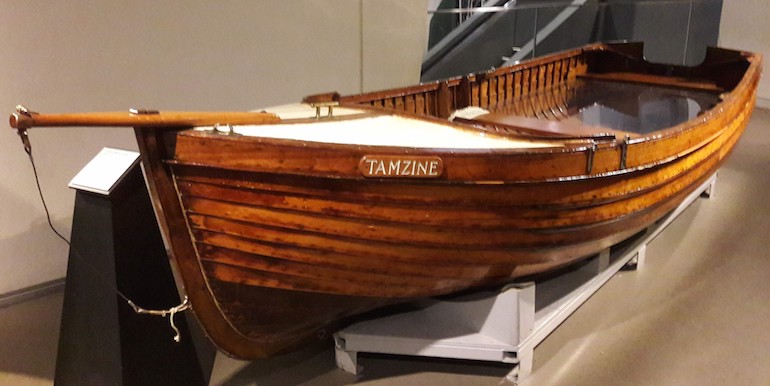 Tamzine ship at Imperial War Museum in London. Photo Credit: © Caroline Piper.
Tamzine ship at Imperial War Museum in London. Photo Credit: © Caroline Piper.
3. Winston Churchill’s “Romper Suit” – Stoicism and Eccentricity
Winston Churchill worked tirelessly throughout the war, despite being 65 years old when he became Prime Minister in 1940. He personified British determination with wartime newspaper cartoons depicting him as a British bulldog or with his sleeves rolled up marching into battle. He worked long hours; he dealt with the necessary paperwork of government and spoke regularly in the Commons; he visited different parts of the country to inspect troops and defences, and keep up civilian morale. His wartime lifestyle exhausted those who worked for him. But he did not always wear what you might expect! Churchill favoured an all-in-one outfit known as a “siren suit” which his family called his “rompers” after the romper suits normally worn by babies. He had several in various materials, including this luxurious velvet version, by his Saville Row tailors, displayed at the Churchill War Rooms.
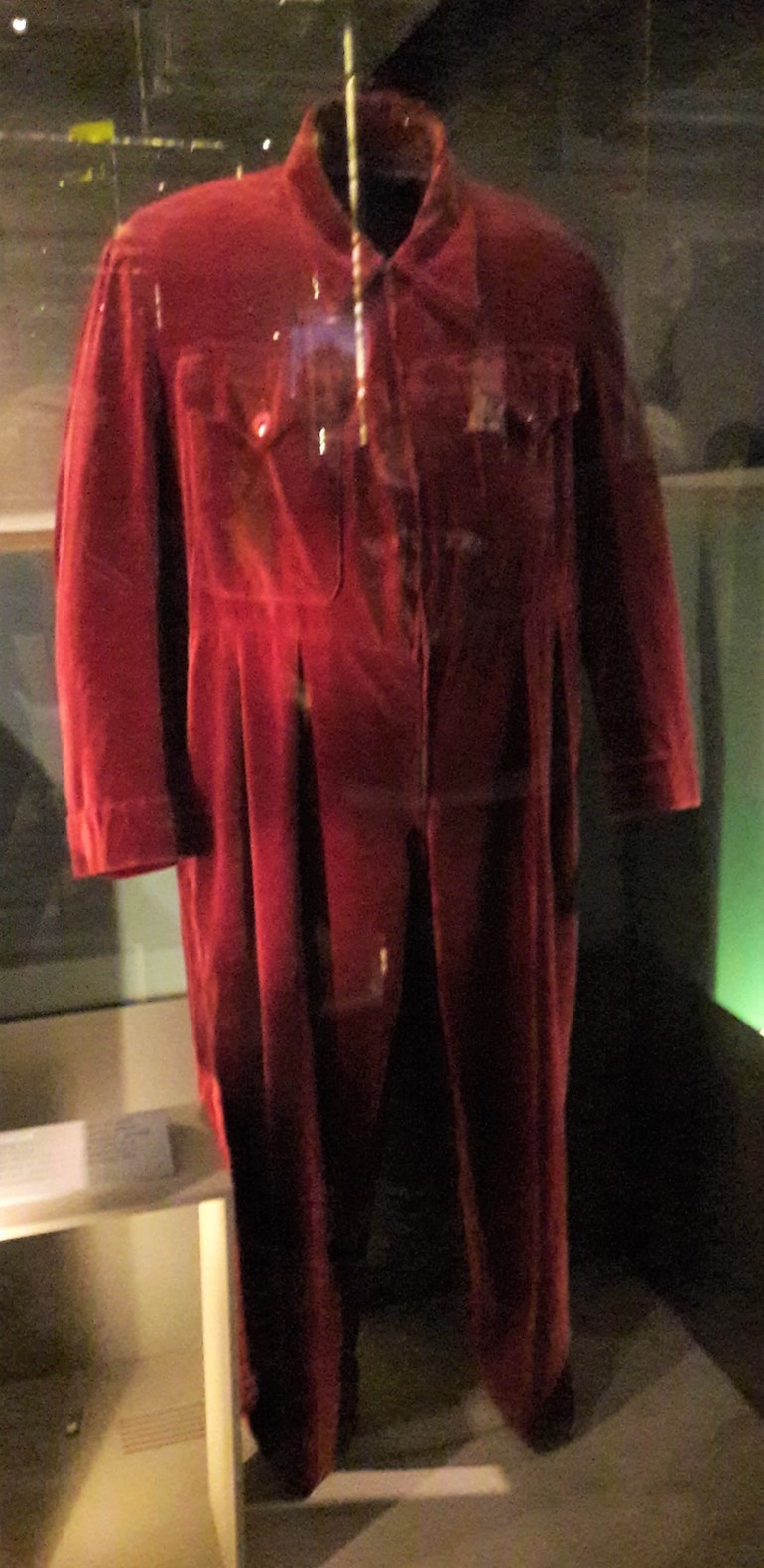 Romper suit at Churchill War Museum in London. Photo Credit: © Caroline Piper.
Romper suit at Churchill War Museum in London. Photo Credit: © Caroline Piper.
4. The LRDG Truck – True Grit
The Long Range Desert Group (LRDG) was a British army unit operating behind enemy lines in the desert war of North Africa from 1940 to 1943 using this truck which is exhibited at the Imperial War Museum. This particular vehicle went on missions to gather intelligence and harry the enemy in the Libyan desert and was christened “Waikaha”, a Maori name chosen by a member of its New Zealander crew after the place his family came from. As well as reconnoitring enemy positions, for six months the LRDG supported the newly formed Special Air Service (SAS) on its raids into enemy territory, earning themselves the nickname the “Libyan Taxi Service”. From July 1942 the LRDG acted as British General Montgomery’s eyes and ears. They even crossed the deadly Qattara Depression into the heart of Libya, an inland sea of quicksand, which the Axis powers thought inaccessible – but not the LRDG! The unit was disbanded in 1945 and this is the only surviving LRDG truck, found in the desert in the 1980s by a group of British geologists!
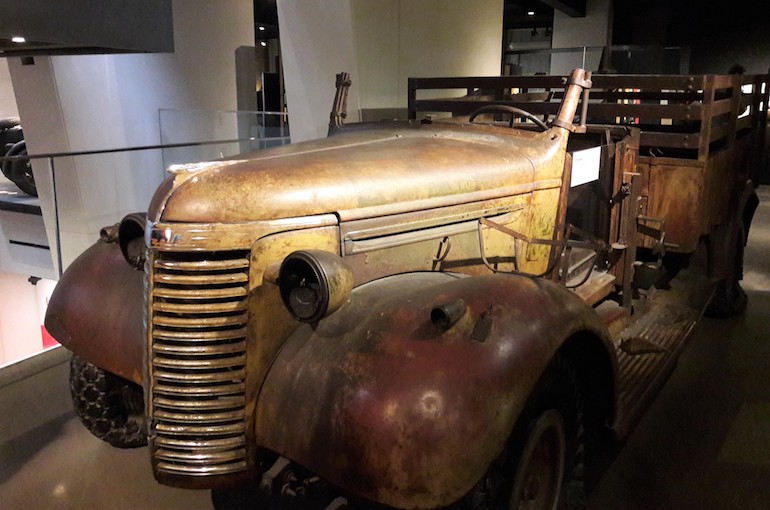 LRDG truck at Imperial War Museum in London. Photo Credit: © Caroline Piper.
LRDG truck at Imperial War Museum in London. Photo Credit: © Caroline Piper.
5. King George VI’s Letter to Winston Churchill – Loyalty and Sense
Note the date of this letter – May 31st 1944! In the spring of 1944, Britain was the springboard for Operation Overlord, the Allied landings in Normandy. On 6th June 1944, the Allies would land on five beaches in Normandy and begin the fight across occupied Europe to Berlin. Winston Churchill, always an eccentric, wanted to be in the thick of it! As Prime Minister, he had made himself Minister of Defence and insisted on overseeing how the war was fought. His ideas on military strategy could inspire or alarm his Chiefs of Staff and it could be hard to make him listen to their advice. In May 1944 Churchill was determined to be present at the D-Day landings, and only this letter from King George VI, displayed at the CWR, was able to make him reluctantly change his mind. From a shaky start, Winston Churchill and the King had grown very close and Churchill was prepared to listen to the King’s advice “I don’t think I need emphasise what it would mean to me personally, & to the whole allied cause, if at this juncture a chance bomb, torpedo, or even a mine, should remove you from the scene……in all seriousness I would ask you to reconsider your plan.” Thank goodness for such common sense!
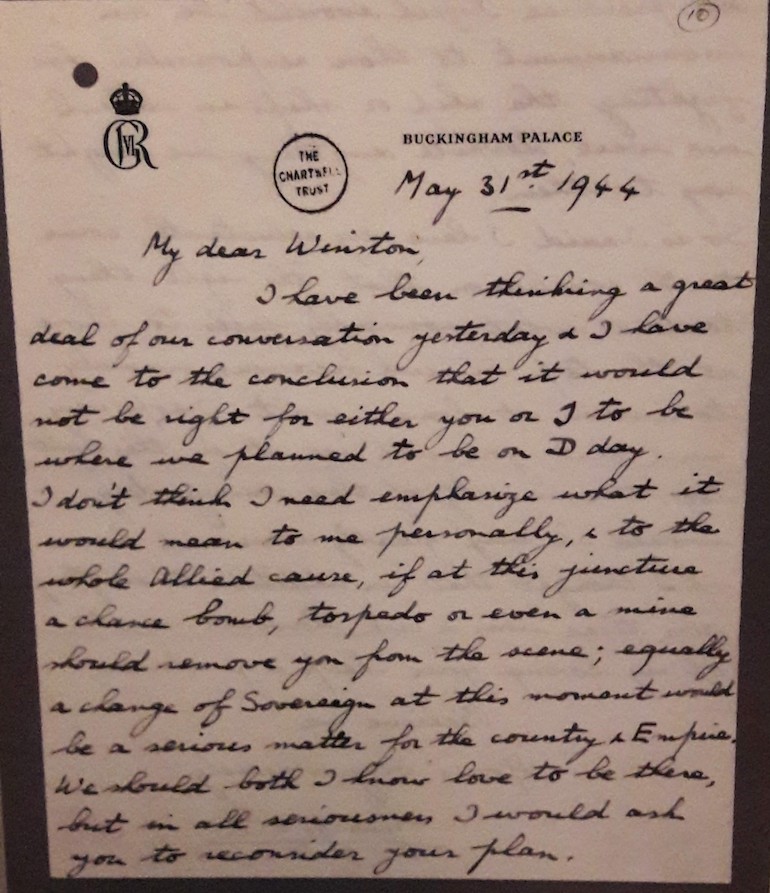 Letter from George VI to Winston Churchill. Photo Credit: © Caroline Piper.
Letter from George VI to Winston Churchill. Photo Credit: © Caroline Piper.
6. An Eagle from the Reich Chancellery – Reprieve
In April 1945, the Soviets launched the Battle of Berlin, with the Red Army fighting for Berlin street by street and house by house, as Hitler refused to allow the German army to surrender. On 30 April 1945 he committed suicide in his bunker deep under the Reich Chancellery, the traditional office of the German Chancellor and of Hitler as Fuhrer. The Chancellery had been built in 1939 as a symbol of Nazi Germany by the architect Albert Speer in a typically heavy, authoritarian style and decorated with stylised bronze eagles, each clutching a swastika in its claws. The exhibit in the IWM is one of them. It bears the scars of the fighting, a broken wing and ripped bronze. It is a symbol of the arrogance of the Third Reich and the pity of the broken Germany at the end of the war. For Britain, it meant an end to the war in Europe – reprieve!



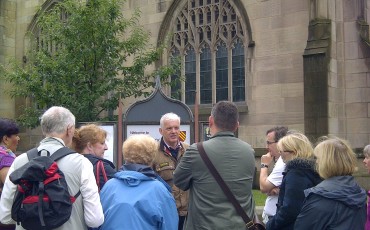
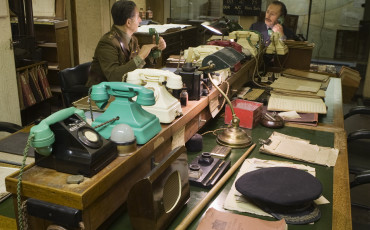


Leave a Reply